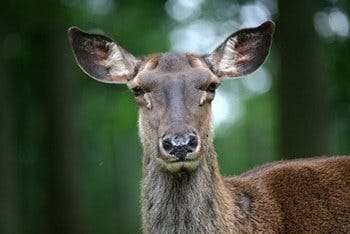The mating behavior of the Caspian Red Deer, or: why resilience is essential
Roma Fiumicino Airport. Saturday night. We’re not here to party, we’re here to fly home, slightly buzzed from the large Aperol Spritz they…

Roma Fiumicino Airport. Saturday night. We’re not here to party, we’re here to fly home, slightly buzzed from the large Aperol Spritz they do so well in Italy. And tired. Very tired. The month of October has been very straining on all of us; I’d even go ahead and say that this month was one of the most emotionally challenging months of my life. We had just interviewed a ton of nurses, and were now looking to get our mind off work — which is really hard sometimes when you’re an entrepreneur. The thing that allows me to focus on one and one thing only is writing. I also work really well with challenges, so again I asked Kai, who was sitting next to me, for a topic.
A topic? “Yeah dude, just any topic. Like the cutlery last time.” — “oh, okay.” … and then he proceeds to drop this: “The mating behavior of the Caspian red deer”. Shit. I don’t even know what a Caspian red deer is. Let alone what their mating behavior looks like. And then I shall extract a life lesson from that? God damnit. That’s hard. Or is it? Well, I did some research and I have to say, this Caspian red deer is actually a fairly interesting breed. Let’s dive in!
The crazy world of the Caspian red deer
The Caspian red deer (cervus elaphus maral) is a subspecies of the red deer (cervus elaphus) that lives in the area between the Black Sea and the Caspian Sea, mostly on the Crimea peninsula (yeah, the one Putin tried to annex — probably not due to its awesome deer population though), Asia Minor and the Caucasian Mountains. It’s pretty heavy, weighing in at 230 to 320 kg. Would definitely be a good fit for an American Football team, preferably at left tackle due to its agility. In order to fuel the engine, it also has to eat a lot: usually grasses and young tree shoots, along with some bark. 25 liters of that, every day. Kind of like eating a school backpack full of food every day. Finding and eating that amount of food takes a lot of time, around 10 hours a day.
Short aside here: the “eating bark” thing is actually a problem. As you know, bark is one of the most crucial parts to a tree’s survival — and if it loses too much of it, it won’t be around for long. Red deer kill trees, and then they make sure that they ain’t coming back by eating all the young tree shoots, whose nutrients are very important to the red deer’s nutrition. This is the reason why red deer is hunted more than other species living in the wild. They wouldn’t eat as much bark if they could live in a non-forest region with lots of grass; but the hunting drives them back to more densely forested areas. And in these areas, aside of bark, there isn’t much too eat. It’s kind of a chicken-egg problem without a real effective solution. So next time you see a tree whose bark looks awful, it’s probably thanks to the red deer. And if you happen to be in the Crimea region (which I would advise against), then it was probably a Caspian red deer.
Other than that, the red deer live in two different herds: a so called “Kahlwildrudel” (sadly, there isn’t a proper English terminology here) which consists of families of 3: the mother animal, a one-year old and a calf. The males live in a separate gang, roaming the forests and plains of the Caucasian Mountains and eating like a Olympic powerlifter. Basically just some dudes hanging out, and it’s girl’s night out all the time — with the kids. Or something like that. Very hard to imagine for us humans. That’s the majority of the year. And then there’s the mating period.
The mating period
This is where it gets interesting: roughly in September, the first mating roars start to emerge from the forests (a very impressive recording of the sound can be found here — not too distant from the sounds at a male bathroom stall at the airport). It’s mating time, or “rut” as I’ve just learned. The male gangs start splitting up and approaching the ladies in their Kahlwildrudel, just like in a club on a Friday night. However, contrary to the club, the caspian red deer has the ultimate “winner-takes-it-all” mentality. In order to get to the ladies, a few things have to be sorted out first. Most importantly, who the strongest dude in the group is. To figure that out, the stags engage in a ritual-like fight, where they walk side by side for about 5 minutes, presenting the size of their body, before they with a sudden movement engage in a fight using their antlers. This fight lasts until one of them decides to concede and run away — usually either for reasons of weakness or injury. Every year, 5% of red deer are killed in these fights — also different than in a Friday night club. These fights go through sort of a tournament mode — I wasn’t able to find out if it’s single elimination or more of a league system — until eventually, a winner is determined. This winner then gets to mate with all the ladies. Doesn’t that sound lovely, folks?
The other poor stags are stuck hanging out in the vicinity of the herd while the victorious stag celebrates an excessive sex orgy. An orgy that lasts for 6–12 weeks. Usually, the winner is an older stag (of course, experience tends to win), BUT: older stags also shed their antlers first, and once they don’t have antlers anymore, it’s easy for the younger stags to challenge and usurp him. So then, the younger stags also get to their part. But as you can see — it’s never going be enough for all male deer, which means that many of them will probably die lonely and single. But at least they have their bros to hang out with all year.
So we have the fighting and the orgy part. Now, do you remember what I said about their usual everyday activities? That’s right — usually these animals eat for 10 hours a day. If you’re fighting and having sex all day, you naturally don’t have that much more time to eat, which leads to most males losing up to 20% of their weight during rut. In normal scenarios, this isn’t a problem — they will just refeed, get some protein shakes and put their weight back on. But sometimes, the weather does what it wants. Like when it’s incredibly sunny outside and I figure I’m not gonna need a rainjacket, only to stand in pouring rain 10 minutes later. Rain doesn’t hurt the stags, but winter comes very early sometimes, especially in the areas where the Caspian red deer live. Winter means a much shorter supply of food, which again means that refeeding is almost impossible. Being almost anorexic highly hurts your chances of survival in a rough winter, which leads to the death of many stags. So literally they die from the consequences of fighting for the opportunity to have sex. Men …
Resilience
The winter wouldn’t be an issue if the stags were 100% in shape and had their full level of resilience. But due to long periods of exhaustion, smaller things all the sudden become very big and sometimes deadly. And I believe that this is something that we can all take away for ourselves: if you’re in great shape, physically and mentally, no matter what happens will probably not faze you. On the other hand, if you’re constantly stressed, sleep-deprived, eating pasta and burgers all day and haven’t seen the inside of a gym for a month, chances are that even smaller events will completely shut you down.
As mentioned earlier, the month of October was a very stressful one and very straining. Under other circumstances, it would have taken an even greater toll on me, but luckily I came into the month healthily, in arguably the best shape of my life and with only mediocre stress levels. Therefore, I was able to absorb all the blows thrown at me. I was resilient.
Now, how do you build this resilience? Well, if I’m writing this — what else could it be but my favorite topic? That’s right. You form resilience through habits. The philosophy with which I approach my day is that by the end of the day I wanna say, “it’s been a good day”. In order to achieve that, I have very particular morning routines in place (on which I will publish a newer in-depth article at some point — you can find the old one here, it’s a bit outdated). To me, a definition of a good day is a day where I took care of my body and mind and learned something new while being in control of what’s happening. Therefore, I try to integrate the following activities into my morning:
- making my bed (control)
- meditation (healthy mind)
- foam rolling & stretching or gym (healthy body)
- journaling (healthy mind, learning)
- riding my bike to work (healthy body, also has very positive effects on the immune system)
- listening to audiobooks or podcasts (learning something new)
Once that’s over, the actual day starts. But no matter how shitty the day is, by the end of the day it was still a good day because I achieved all of my goals. Whatever happens, it can’t possibly ruin my day. That’s resilience. And on a larger scale, these behavior patterns also impact your overall outlook on life, leaving you unfazed when faced with difficult situations.
If the Caspian red deer had built that resilience, it wouldn’t have died from an unexpected change in weather. It didn’t. And that’s okay, because in the end, these stags are also just men. And at the end of the day, they’ll probably say: “doesn’t matter — had sex”.
Dear Kai, there you have it — a comprehensive piece on the mating behavior of the Caspian red deer. Hope you (and all you other readers) enjoyed the read! I’m always happy about feedback, positive or negative, and if you feel like it you can even drop me a topic to write about — either because you’d like to know more or you simply wanna challenge me. Either works. Until then, take care and stay awesome!
If you want to build resilience, too, I’d suggest checking out my blogpost on routines. That will give you a first glimpse about what you can do.
This post was originally published on dominiknitsch.com. Check it out to learn more about me and what I do, and subscribe here if you want to constantly be up to date!
Dominik Nitsch Newsletter
Join the newsletter to receive the latest updates in your inbox.


